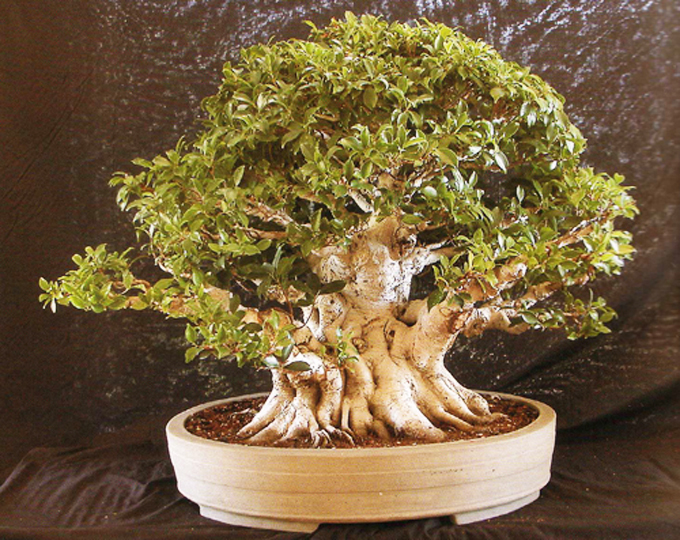 This powerfully built gem is from Ficus, the Exotic Bonsai by Jerry Meislik.
This powerfully built gem is from Ficus, the Exotic Bonsai by Jerry Meislik.
Cattle cars with wings
I’m headed out again. Tomorrow will be another day spent in an airborne cattle car. Then Thanksgiving with family. I know there are many people who’d rather the time in the cattle car than time with family, but I’m one of the lucky ones in that regard. I like my family. No know-it-all ramblings or ill-tempered put downs on the menu, though if someone is going to misbehave, it’s more likely me than anyone else (only a little and almost always with a sense of humor).
So, what I’m trying to say is, time is getting a little compressed and I’m up to my old tricks; plundering our archives and recycling yet another post. This one is from almost four years ago, so my best guess is you haven’t seen it anyway and if you have, you’ve forgotten it.
And… as a favor just in case you have seen it (and you remember it), we’ve added a little value. Namely larger photos, and, of a more questionable nature, a few more words by yours truly.
Big ficus fan
If you want to grow bonsai indoors (winter or year round), you’ll be hard pressed to find subjects better suited than ficus, though some varieties are better suited than others. A couple that I’ve had luck with are the Green Island (F. microcarpa) and the Too Little (F. benjamina ‘Too Little’). I’ve also had some luck with the Willow Leaf ficus (F neriifolia – there is some disagreement about the botanical name – here’s a discussion by Robert Kempinski, author of Introduction to Bonsai). If you have any experience with other varieties (successful or otherwise), let us know.
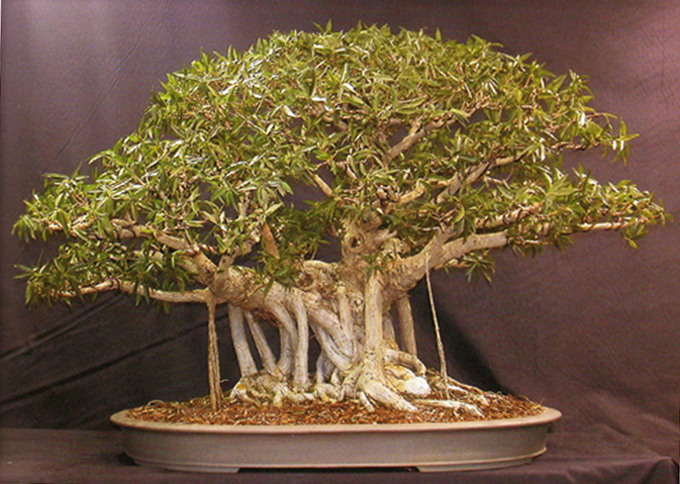 A large Willow leaf ficus with some impressive aerial roots from Ficus, the Exotic Bonsai.
A large Willow leaf ficus with some impressive aerial roots from Ficus, the Exotic Bonsai.
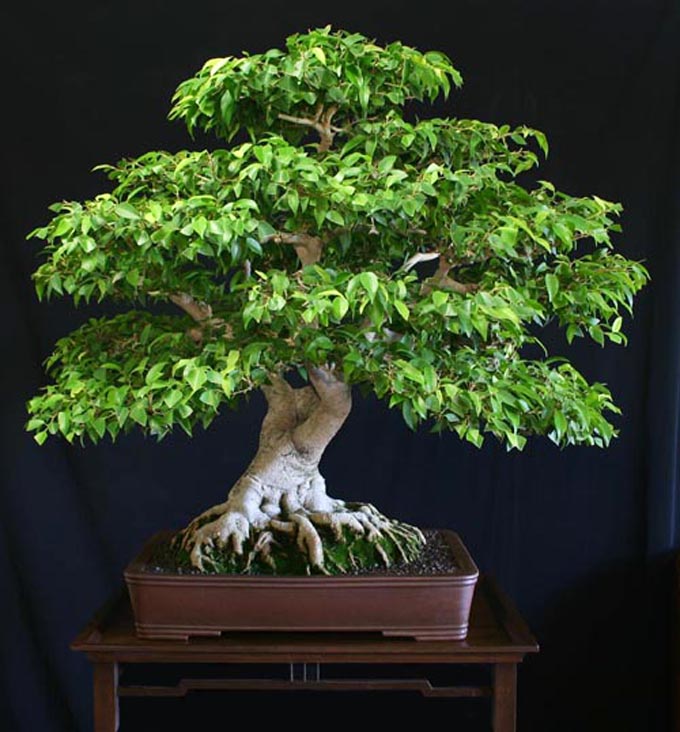 A large Benjamina with a well developed nebari by Bradley Barlow.
A large Benjamina with a well developed nebari by Bradley Barlow.
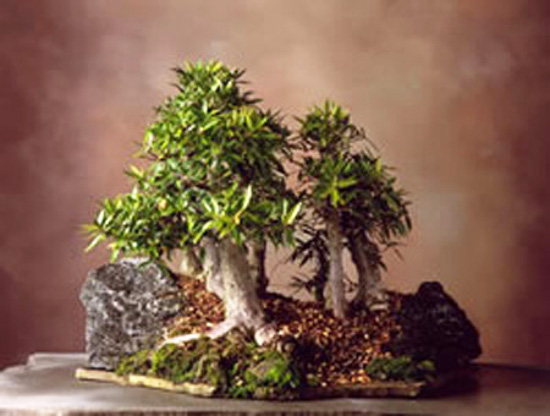 This simple Willow leaf planting is from a bonsai exhibit on Morikami Museum & Japanese Garden website. Though it’s far from a masterpiece, it does have some charm and is the type of project that almost any beginner might attempt.
This simple Willow leaf planting is from a bonsai exhibit on Morikami Museum & Japanese Garden website. Though it’s far from a masterpiece, it does have some charm and is the type of project that almost any beginner might attempt.
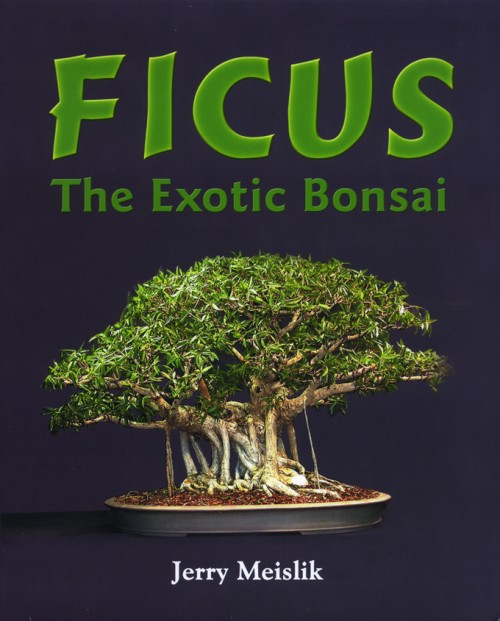 The classic for Ficus and other bonsai that are suitable for growing indoors. Available at Stone Lantern. List price 27.95. Now on special for only 19.95.
The classic for Ficus and other bonsai that are suitable for growing indoors. Available at Stone Lantern. List price 27.95. Now on special for only 19.95.
Ficus natalensis is an exceptional species. They’ll take cold down to the mid-30s, leaves easily reduce to 1/2″ or shorter, do well under lights in the winter, readily put out areal roots, and grow like weeds. They’re a member of the “strangler fig” group, so all sorts of interesting possibilities exist in terms of form, shape, etc. Multiple cuttings will readily fuse together to form a larger trunk in a hurry – not unlike Doug Philips method with trident maple cuttings. They are strongly apically dominant, so that needs to be kept in check in order to keep things in balance. Otherwise, for shohin and chunin sized trees, I find them to be better than any other Ficus species out there.
Where can we purchase a Ficus natalensis?
Because of apical dominance and restriction of growth by repeated cutting back in the top section of not only F natalensis, they ramify very well at the top of the tree and this causes a problem. You are stuck with dense growth at the top and the lower branches become leggy. This has no easy solution, believe me. I have been growing them for thirty years and more. It also means that because of measures taken to resolve the problem, they are often in periods of restoration and not acceptable for display. This really (admittedly) happens with older trees. I don’t mind and will keep on growing and styling these wonderfully reactive trees.
We also have experience with F natalensis since our days in South Africa and nowadays grow them in New Zealand where they have adapted very well to the temperate climate. We have gone another route with F natalensis – we use its best qualities namely, fast growing, ability to merge and develop a reasonable trunk with the smaller leaf size of what we call “natalensis nana” – a very small leaf subspecies. By grafting the small leaf variety onto ordinary natalensis, we get smaller leaves and slower apical growth. Ficus burth davyii or F. burt davyii nana can also be used for grafting (if it is available) as the leaf size is much smaller than natalensis. By grafting with grafting tape we gradually replace all branches and leaves of the mother tree with small leaf natalensis with good results.
I like my Ficus’ very much. The fact that they grow fast is a plus in NY, as well as their tolerance to low light. I have been experimenting with fusing F benjamina cuttings. It took a while, but they are now one tree. I look forward to styling it in the spring.
Happy Thanksgiving!